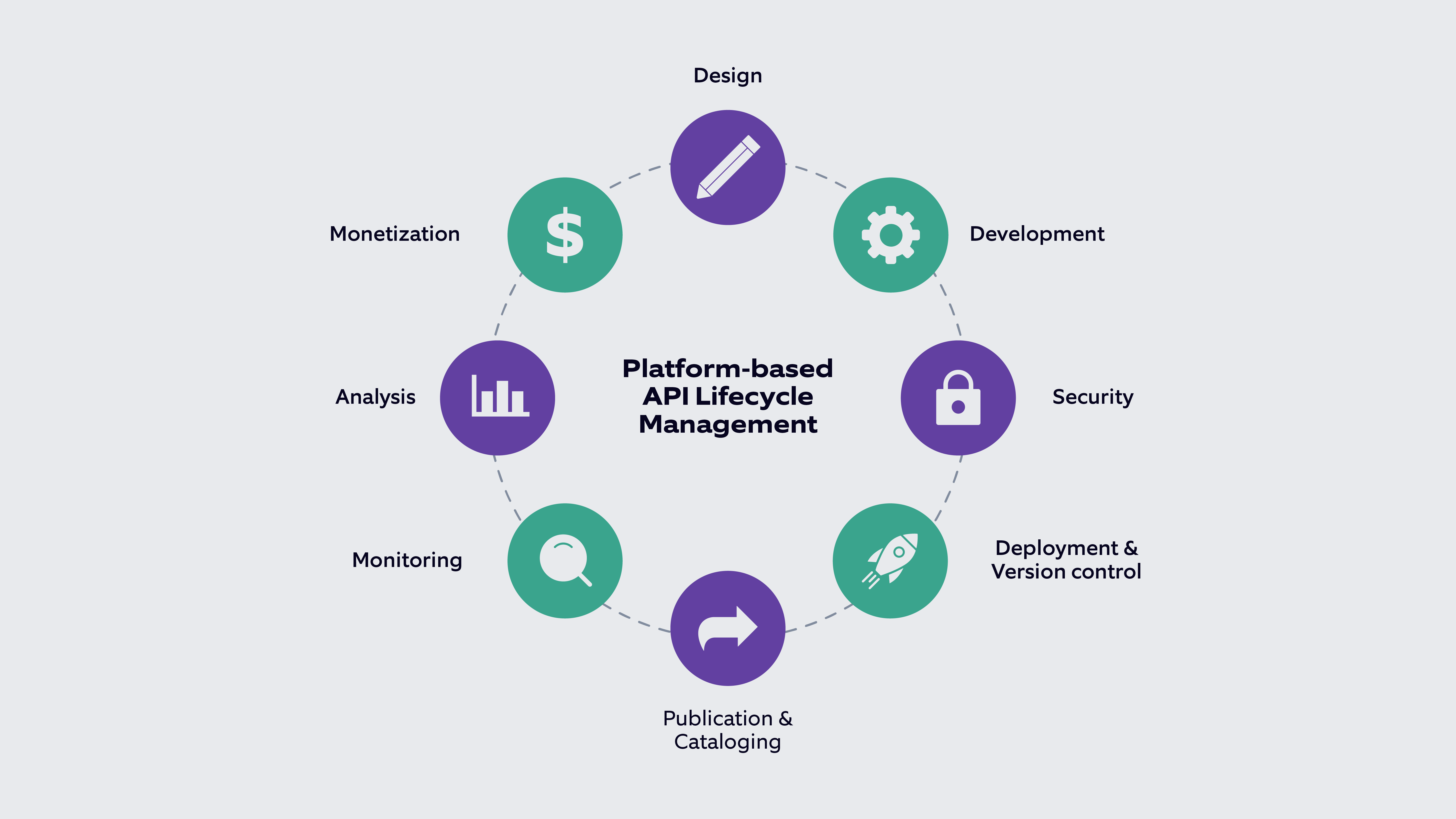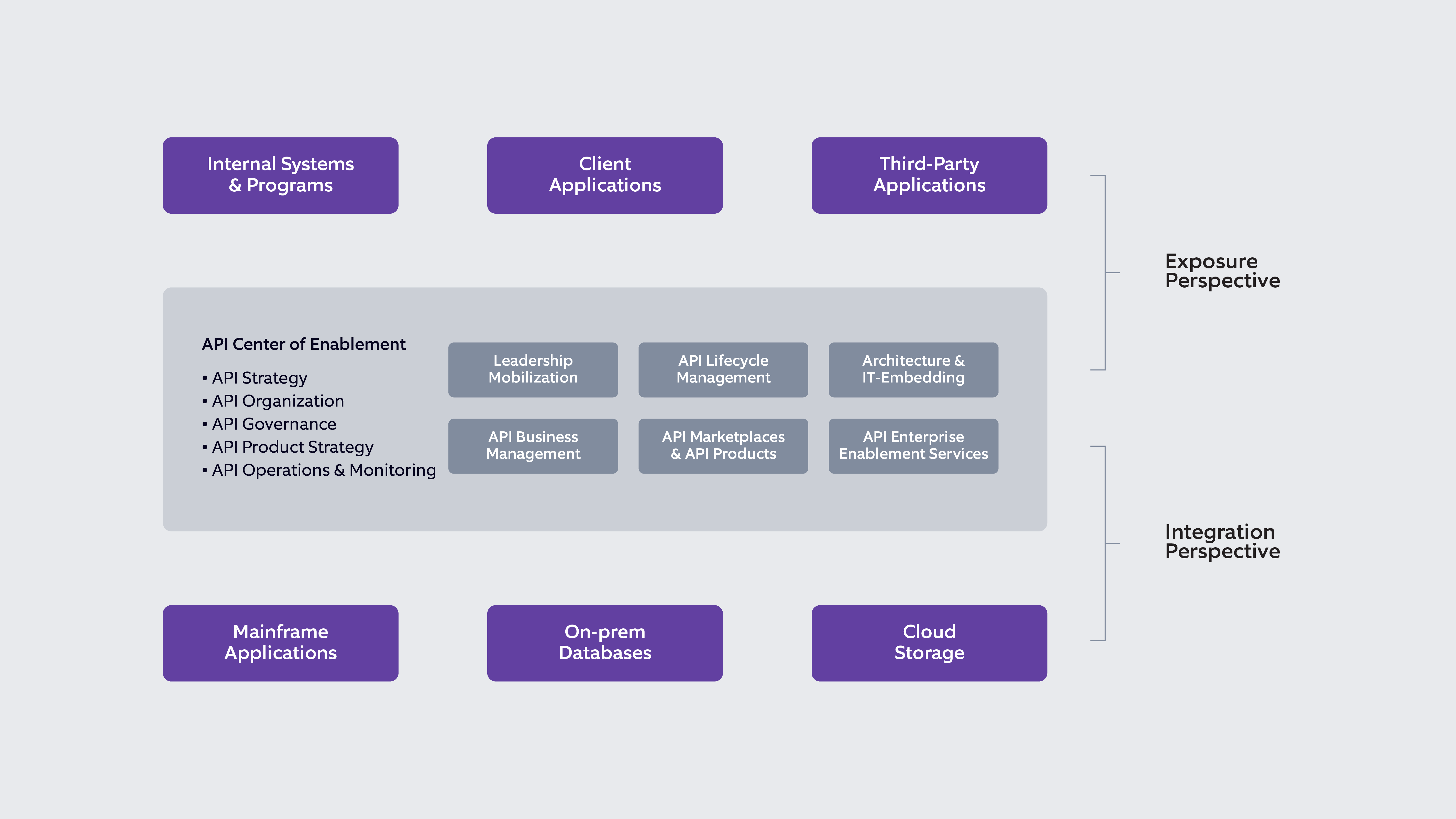Here’s what I have gained from my work with numerous clients as a Practice Leader in API Management at Nagarro: API Management is meaningless without digital business ambition and digital business ambition is blind without API management. Both are integral and complementary to each other. Through this article, I aim to explain the potential opportunities and conceptual foundations of API Management. In addition, I also discuss the success factors and share how to get going with API implementation. These concrete recommendations will help you tap the potential of API-supported transformation and innovation, and can drive your business forward.
Classification and potentials
With digitalization progressing rapidly, we are increasingly seeing the rise of platform-based business models, "smart" products, and multi-channel approaches for consistent, tailored interaction between actors in the value chain. These developments are driven by various factors: Increasingly demanding user and customer behavior, new regulatory requirements, and the entry of players who were once outside the industry into the relevant competitive arena. All this has given rise to potential opportunities for companies. These opportunities call for future-oriented corporate management in order to achieve corresponding higher revenues and reduced costs:
- Expansion into additional markets and customer segments
- Higher absorption of willingness to pay through novel products
- Increase loyalty and purchase value through improved customer experience
- Triggering a promoter effect by mobilizing the partner ecosystem
- More intensive multiple use of already existing data and APIs or functions
- Extensive automation of workflows in the context of data exchange
- Encouraging agile working, strategic adaptability and further scaling
By tapping into these potential business opportunities, companies can maintain and expand their competitiveness vis-à-vis their market competitors. They could even forfeit them gradually if they fail to exploit them. API management plays a key role here by orchestrating a secure and consciously controlled data flow between applications and systems. In my view, this consciously-controlled data flow is an essential "enabler" for digital transformation and business model development - both internally and externally directed.
What is API management and why is it needed?
API management describes a concept that relates primarily to the process of developing, publishing and controlling application programming interfaces (APIs). For the benefit of the uninitiated, APIs are mechanisms that enable different software components to communicate with each other through a set of definitions and protocols. They unify data exchange and should meet requirements of developers and applications accessing an API. While specific API management requirements typically vary by organization, in general, API management solutions cover basic functions along the API lifecycle. These include standardization of API development, enforcement of API security requirements, establishment of API governance, and cataloging, version control and publication of APIs. That’s not all, API management solutions also provide KPI-based monitoring, analysis of usage and access patterns, API packaging and monetization. In this context, we can understand APIs as B2B products aimed at internal or external developers. They can either serve as intermediate products to refine applications or can be marketed independently as data services. In both cases, they pass through the so-called API lifecycle, as illustrated in Figure 1.
 Figure 1: API Lifecycle
Figure 1: API Lifecycle
The technical basis of an API management solution is a platform that is intended to provide functions in the API lifecycle consistently and, above all, more efficiently. It is divided into three levels:
- Management level, which comprises an API portal, much like an advanced API marketplace or a more basic developer portal, supplemented by an API analysis module as the basis to monitor metrics.
- Control level, which consists of an API lifecycle manager and an API policy manager to ensure compliance with standardization, access and API security requirements.
- Data level, which contains API gateways that connect data sources to developers or applications, allowing data exchange between API producers and consumers.
At Nagarro, we believe that the selection, design, implementation, operation and scaling of a platform-based API management solution should not be considered and approached in isolation. A platform-based API management solution must be embedded in the existing IT landscape and closely interwoven with the overall business and IT strategy.
Success factors for API management
Given API’s technical nature, we usually see the IT department in a company as the right fit in the role of initiating and responsibly driving forward the topic of API management. But it most also be noted that in view of the potential opportunities outlined above, we also believe that API management should be thought out strategically, anchored throughout the company, and designed on an inter-disciplinary basis. Only if business and IT work hand-in-hand, will they be able to leverage API’s value potential comprehensively and open up new scope for entrepreneurial success.
The following steps are crucial in ensuring the successful implementation of platform-based API management:
- Identify and evaluate the value potential of platform-based API management for the company, if necessary, with the help of proof of concepts (PoCs) for prioritized use cases.
- Develop a broadly co-ordinated API strategy that can serve as a bridge between functions and divisions, and drive operational API use in the company.
- Establish a co-operation model as the basis for value-creating collaboration between business and IT, and expand it with external partners and stakeholders.
- Implement the API system landscape, defined by appropriate APIM platform(s) and complementary software products, e.g. for monitoring or API security.
- Identify, build, and sustain the required capabilities and resources within the organization.
We recommend addressing these points as early as possible to ensure a step-by-step implementation.
Building blocks to successfully implement API management
We distinguish between integration and exposure perspectives in order to work out and extensively discuss the building blocks to introduce and scale API management with our customers. Figure 2 illustrates the structure of the API architecture and classifies these two perspectives:
 Figure 2: Classification of perspectives on API Architecture
Figure 2: Classification of perspectives on API Architecture
From an integration perspective, the focus is on how a platform-based API management solution can access data, especially in mainframe applications, on-prem databases, and cloud storage. We also focus on how to ensure its availability for deliberately controlled data flow. In this context, we see the following use cases as particularly exciting starting points:
- Modernization of existing enterprise architecture, using microservices, "API-first" (design) concept and security principles
- Designing and implementing a middleware transformation to overcome data and API silos, both internal and external to the enterprise
- Unlocking the full potential of cloud transformation, based on "API-first" principles and platform capabilities
On the other hand, from an exposure perspective, the focus is on providing available data for consumption or processing through technical endpoints. From the perspective of implementing API management, we see the following use cases:
- Technical implementation of business strategies that include, for example, smart products and platforms or omnichannel approaches
- Deriving an API (ecosystem) strategy that defines, in particular, API marketplace and API products as well as their monetization
- Definition and implementation of an API platform strategy, flanked by cultural and organizational measures
Depending on the perspective, there are differences in terms of objectives, starting points, and approaches. As an example. let’s take a closer look at a use case for each perspective:
"Middleware Transformation" as a scenario from an integration perspective
In the real world, we frequently encounter the use case of middleware transformation. In this context, middleware can be understood as software between an operating system and the applications that run on it. In principle, it acts as a hidden translation layer that enables the communication and data management of distributed applications.
Middleware transformation aims at higher flexibility and cost advantages (as a result of structural optimization) and improved integration with regard to legacy systems as well as new infrastructures and applications. After defining modernization goals and the need for action, we recommend working out a future-oriented transformation architecture. In this way, the tools, technologies and participants required for such a transformation can be identified appropriately. We must also accord due consideration to selecting and implementing a well-planned migration approach, e.g. "lift-and-shift", refactoring or re-platforming. A consistent "API-first" (design) concept, microservices, and a platform-based API management solution with multiple integration options can play a key role in the success of the transformation architecture.
"API marketplace" as a scenario from an exposure perspective
An API marketplace connects API producers with API consumers so that they can exchange data, based on uniform rules on technical and commercial aspects. It is the most advanced level of data exchange in terms of automation, security level, analytics and monetization capability. A “less advanced” level can be understood as rudimentary API catalogs and more powerful developer portals. The establishment and operation of an API marketplace is usually embedded in the (further) development of an API strategy, with which a company wants to express and enhance its corporate and IT strategy. This is done regarding the relevant ecosystems, to establish a model for co-operation between internal and external stakeholders, and to define the logical structure of its platform-based API management solution. The important thing here is to achieve effective value addition in terms of revenue and costs, thanks to improved customer experience, new or enriched services, expansion into new customer segments or markets, and more intensive multiple use of existing data and APIs.
Before beginning any such project, it is important to first outline a clear target and then concretize it with regard to stakeholders, value propositions as well as technical standards and functionality. In this way, capabilities that are still missing - for example, workflow and feedback management, integration of third-party APIs in the offering catalog, analysis and monetization of API usage, linking with existing API gateways - are specifically identified and can then be developed or procured. While this is primarily a technical challenge, it must be effectively flanked by organizational and process measures and change management. In this way, effective co-operation can be established across functional and departmental boundaries. It is also important to support the development of an API marketplace, with an operating concept that institutionalizes KPI-based monitoring and performance improvement.
Conclusion
Platform-based API management goes well beyond just designing and developing APIs. It should be understood not only as an IT topic, but in fact, as an "enabler" for digital transformation and business building. If decision-makers from IT and business use this "enabler" for the modernization of enterprise IT and the development of new services, smart products and innovative business models, it would ensure that enormous potential opportunities can be tapped. Therefore, we believe that this topic should be a priority at a Board or executive management level.
Designing, implementing, and scaling API management is typically a complex, multi-year transformation journey. Carefully selected IT partners can be instrumental in setting the right course and achieving the (interim) goals during such a journey. This is where Nagarro can be of enormous help to you, through its impeccable credentials, invaluable years of experience and extensive expertise in designing, implementing, operating and scaling customized API management solutions across various scenarios and industries.
Let's talk about how you can successfully design and implement your transformation journey: apim@nagarro.com.
To know more about API management and how we can help you with it, explore our API management services.





